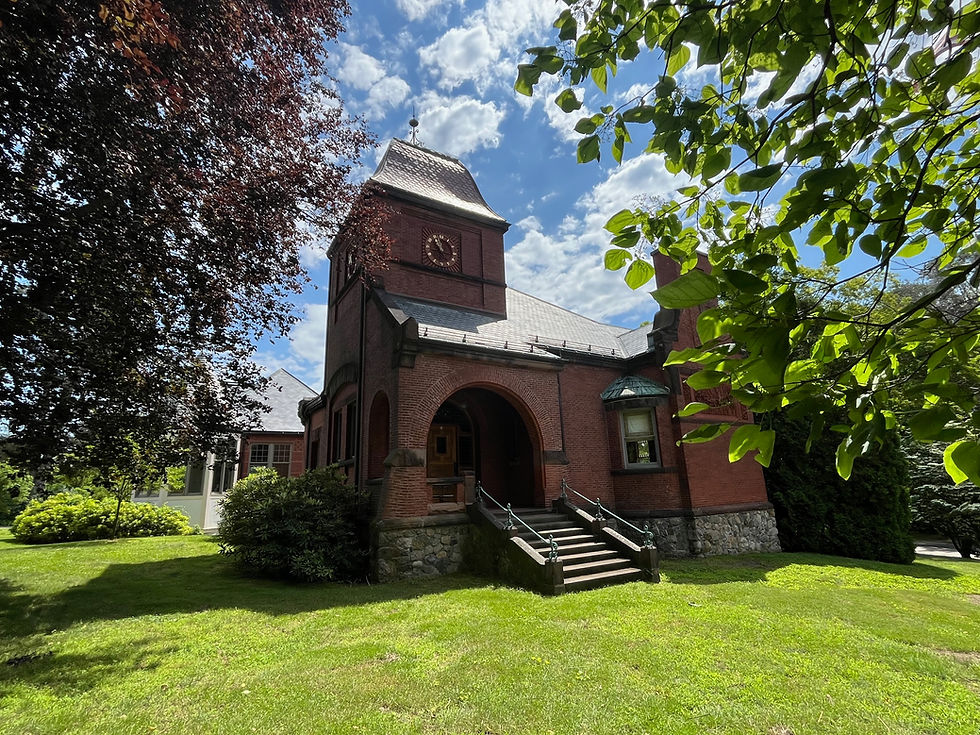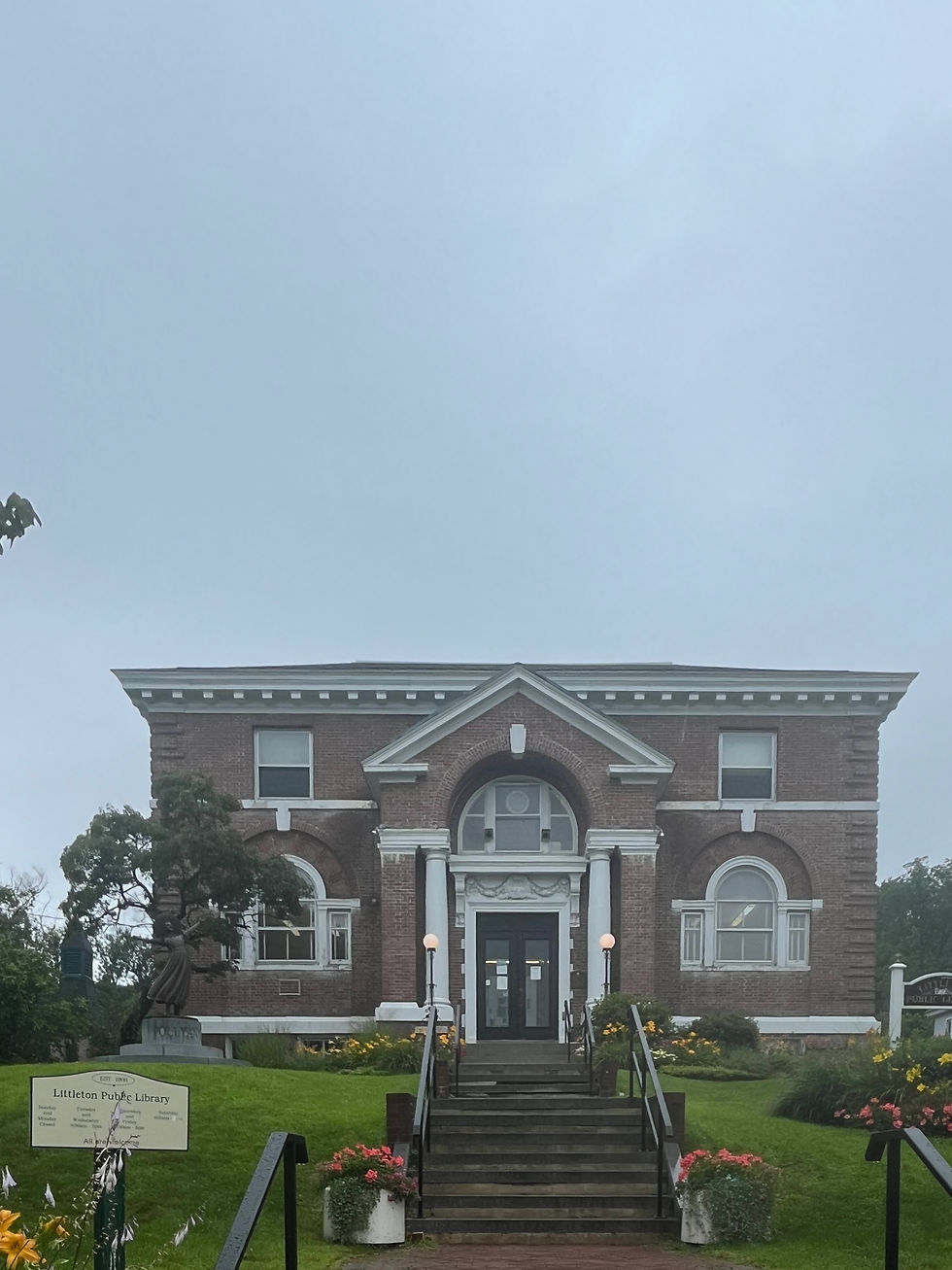Exploring Massachusetts Public Libraries: Mainly Middlesex
- Mark Carl Rom
- Jun 25
- 4 min read
June 22, 2025
I’m itching to travel this morning, so I’ll scratch it. Visiting local libraries is easier on Sunday, as the traffic is lighter. So after attending a recovery meeting (it’s a “Gratitude Sunday”) and church (Sam, our Vicar, sermonized eloquently), I’m off on a clockwise loop around Middlesex.
Once again, a man of the cloth and a woman of the spirit made things happen in Lincoln (the town was named after Lincolnshire in England, not Abraham of Illinois). Paul Revere was captured by the British there after his Midnight Ride in 1775, and the band They Might Be Giants named one of its albums after its hometown. Reverend Charles Stearns started a private subscription library in the late 1700s, and Eliza Farrar donated her husband Professor John’s books. A red brick Queen Anne style was built in the 1880s, and a couple of additions have been made since then. A future goal is to listen to the album while reading the poem in one of the library’s stained glass illuminated reading rooms.

The town of Acton is, in many ways, a model of what our country can be. On multiple occasions CNN’s “Money” has cited it as one of America’s best small towns due to its many historical sites, extensive lands in conservation, excellent public schools, broad social networks (for example, its youth sports teams are not organized around the local schools, bringing individuals from different parts of the community together), and its diversity: between 2019 and 2023, nearly 29 percent of the town’s residents were foreign born. What impresses me the most, however, is that in 1999 the town voted overwhelmingly to triple the size of its public library, from 10,000 to 30,000 square feet. It did this while retaining the character of its 1890 red brick and brownstone building. Lovely.

Lucy P. Longley, the librarian of Hazen Memorial Library in Shirley from 1950 to 1972, wrote in her brief account that the town’s library began in 1790. In 1839, the town chipped in $150 and a small reading room, open on Wednesday evenings, was set up in a building on Main Street. Lucy concludes “We are gratified to observe that Shirley people have begun to realize what all do not know or appreciate how valuable an institution the library is, not only as a means for entertainment but as a practical help.”

Mrs. Betsy Hazen entered history in 1892, when in her will she left the town $3000 to erect “The Hazen Memorial Library.” Mr. Thomas Hazen kicked in one-fourth of an acre as a lot for the building. The Hazens presumably wanted the library to last forever, and they didn’t want to wait long for forever to begin: Betsy’s will stipulated that the library must be completed within two years, and the Richardsonian Romanesque building opened in 1893.
Since their inception, Shirley’s libraries had been maintained by volunteers. This changed in 1911 when Miss Grace M. Kilburn was appointed Librarian and Miss Lura A. White was hired as her assistant. Miss Kilburn served for almost four decades, retiring in 1950. The Hazen Memorial Library served the community for 103 years but by 1996 the community decided that “With no room to grow with technology or accessibility a new building was in order.” Library director Elizabeth Wade wrote a grant proposal to the state, which provided some $800,000 with the community providing an additional $1 million through a tax override. The old library is now a private home. (Speaking of which, the old library in Boscawen, New Hampshire, is for sale. If I had $500,000 lying around, I would buy it and restore it.)

When I compare the two buildings I can’t help but ask “Really, it was not possible to keep the original building while adding on to it?” I understand that many factors are in play: Would a renovation be much more expensive than starting from scratch? Did community members simply want a new building, seeing the old one as unfashionable or inconvenient? Does the town have a strategic plan calling for a restructuring of the public infrastructure. Do local firms specialize in construction, not renovation?In my eyes, Hazen’s new building is serviceable, not enticing.

When I see an old library, like the one in Ayer, I want to settle into a comfortable chair and read. When I see today's Hazen Memorial library, I wonder if the dentist who I think must be working there will ask me if I floss. I suppose it makes sense to move the library from the “eclectic” Sarah R.S. Roby Memorial building – the result of Sarah’s $10,000 bequest to the town – which held both library and town hall, into a low slung facility on the edge of town, yet the former attracts me in a way that the latter does not. The historic J.V. Fletcher Library in Westford, built in 1896, has been replaced by a brand new building and, I have to say, for me aesthetically it’s a toss-up (age does not necessarily equate with beauty, and the picture of the older library appears to have all the power lines in front photoshopped out). The Fletcher Library is an intergenerational project: while Mr. Jonathan Varnum Fletcher gave the $14,000 that made the original building possible, his great-granddaughter Ms. Marian Winnek donated the funds to renovate the basement into the Children’s Room. The outfit worn by the Tewksbury Public Library is functional; the Flint Memorial Library’s dress is fancy. Take your pick. De gustibus non est disputandum.












Comments